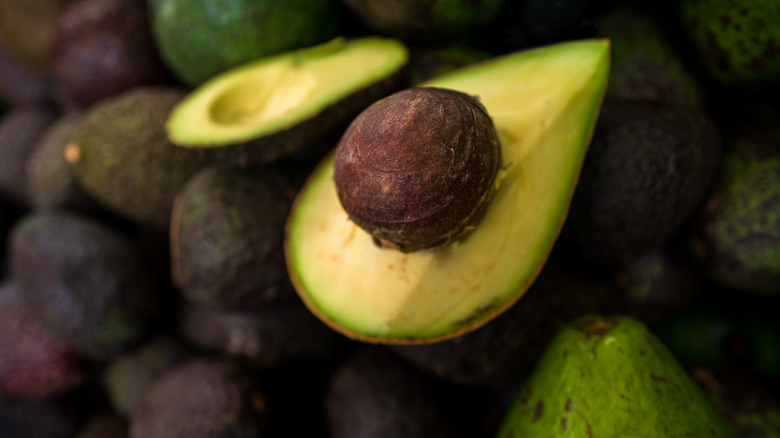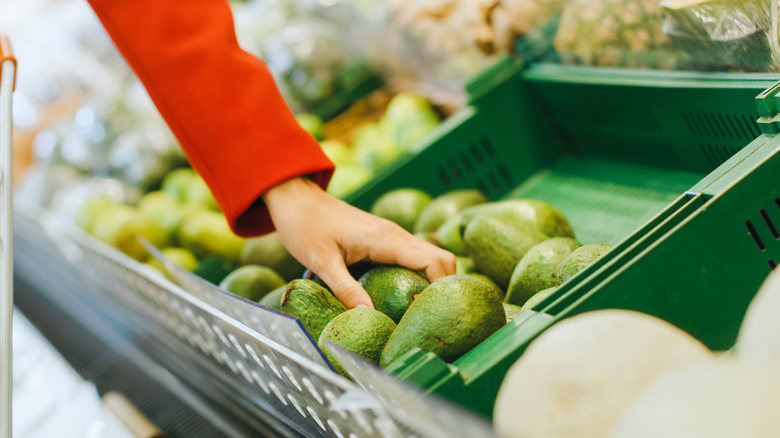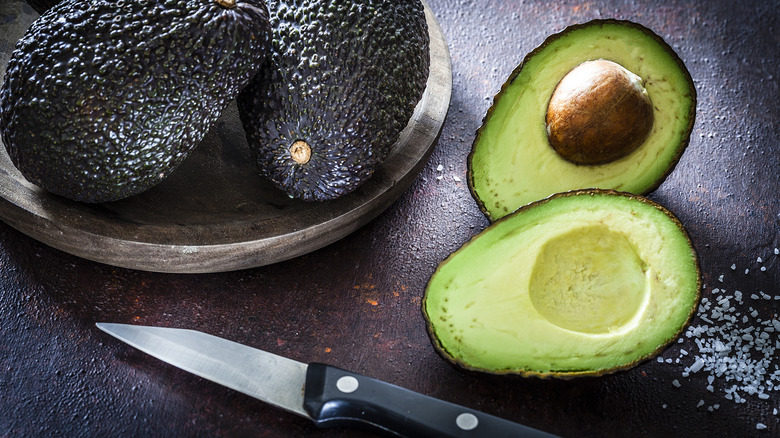Color Is Key When Picking The Right Avocados At The Grocery Store
Selecting a perfectly ripe avocado at the grocery store can be a challenging task, often leading to frustration when the fruit fails to meet expectations upon returning home. After all, nothing is worse than gathering all the ingredients to whip up some crave-worthy guacamole only to realize your avocados are unusable. Luckily, there are a few tricks you can employ to ensure your avocados are the perfect level of ripeness every time, and taking note of their color is step one.
The skin of a ripe avocado will generally appear deep, dark green — almost purply or black — while bright green skin means the flesh inside is not yet ready. The science behind the color change is pretty cool. Avocados are climacteric fruits, meaning they continue to ripen even after they are harvested. During the ripening process, the avocado undergoes a number of small, subtle changes in both texture and color, prompted by a significant increase in respiration rate and the release of ethylene gas, which acts as a ripening hormone. The ethylene triggers a cascade of biochemical reactions, including the degradation of chlorophyll, which causes the avocado to turn from green to black.
It's important to note that turning black when ripe is characteristic of only some kinds of avocados, namely Hass avocados. But these are far and away the most common type sold in the United States, so if you're stateside, color is likely a safe bet with which to gauge avocado ripeness.
Other ways to tell when an avocado is ripe
But you shouldn't rely solely on appearance. There are a couple of other quick tests you can carry out right at the grocery store to help you decide which fruits are ripe. One method is the stem test. Gently rub your thumb over the small stem or cap at the top of the avocado. If it comes off easily and reveals green underneath, the avocado is ripe and ready to eat. If it doesn't come off easily, the avocado is not yet ready.
Another reliable way to gauge ripeness is by touch. Hold the avocado in the palm of your hand and gently apply a bit of pressure. A ripe avocado will yield slightly to your squeeze, similar to the feel of pressing on the pad of your thumb. Avoid avocados that feel too soft, as they may be overripe and mushy inside. Avocados that feel firm or hard are probably underripe and will require additional time to ripen.
Avocado ripening hacks
Speaking of underripe, fear not. There are some last-ditch efforts you can try out at home to speed up the avocado ripening process, although it will still take some time. One popular technique that can help ripen an avocado in 24 to 48 hours is the paper bag trick. Place your avocados in a paper bag with a banana or apple. These fruits emit the ethylene gas, and by enclosing the avocados in a paper bag with them, you create a concentrated environment that accelerates the ripening process.
Another method that relies on the same logic is to wrap the avocados individually in newspaper or aluminum foil. This traps the ethylene gas produced by the avocado itself and can help expedite ripening.
Whatever you do, don't fall for the microwave hack. The internet might tell you that microwaving your avocado will ripen it quickly when, in reality, it will just soften the flesh a little, giving the illusion of ripeness.


